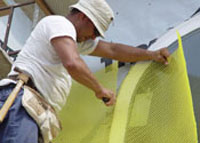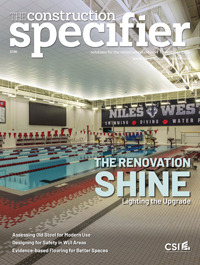Specifying broomed exterior concrete surfaces
ACI 362.1R-12:
A minimum design slope of 1½ percent in any direction, parallel to grid lines and diagonally, should be provided between the floor drain and any point on the floor slabs, except as indicated in 6.2.1.1 [pre-topped double tees] and 6.2.1.2 [corners]. The minimum slope as constructed should be 1 percent. Consider camber and deflections when establishing a drainage pattern. Drainage slope design should take into account dead and live load deflections. The minimum effective constructed drainage slope after volume changes and deflections have taken place should not be less than 1 percent.
The design drainage slope for suspended slabs should be chosen so the as-constructed slope can drain water even when allowing for construction tolerances and deflection. ACI recommends a two percent slope for drainage of suspended slabs in parking structures. Unfortunately, this advice is sometimes not considered when selecting slopes for suspended slabs such as balconies and plaza decks. Often, these slopes are chosen so shallow—1⁄16 in./ft or less—that water will not drain because construction tolerances and deflection offset the shallow slope. Even worse, the water may flow in the wrong direction—in the case of a balcony, toward the door. If a design slope less than 1.5 percent is chosen for a suspended slab, the owner should be cautioned that water drainage will be compromised.
Before choosing the final drainage design slope, the specifier should ask the structural engineer to evaluate the effect of deflection on drainage. This is especially important for post-tensioned cantilevered balconies where the post-tensioning forces often raise the unsupported balcony edge.
Based on many years of parking garage design experience, recommendations have been made with respect to drainage of parking structures and plaza decks. Their recommendations are:
- maintain an absolute minimum slope of 1.5 percent (3⁄16 in./ft);
- cement finishers will have a difficult time consistently achieving a slope of less than one percent (1⁄8 in./ft), if they can achieve it all; and
- when setting slopes on design drawings, be sure to take expected camber and deflections of all members into account—either could reduce design slopes if not recognized and allowed for.
ACI 302.1R-04 recommends a two percent (1⁄4 in./ft) slope, for positive drainage of exterior slabs.
A Texas Transportation Institute study showed the effect of rainfall intensity, pavement cross-slope, surface texture, and drainage length on the depth of water on the concrete surface. Nine test surfaces were placed on individual 8.7 x 1.2-m (28.5 x 4-ft) prestressed concrete double tees. A leveling course with the desired textures was placed on the surface of each double tee. The following variables were considered:
- slopes: 0.5, one, two, three, four, and eight percent (1⁄16-, 1⁄8-, 1⁄4-, 3⁄8-, 1⁄2-, and 1-in. per ft);
- rainfall intensity: 13, 25, 90, and 140 mm (1⁄2, 1, 2, 3.5, and 5.5 in.) per hour;
- texture depth (average): 0.07, 0.22, 0.48, 0.5, 0.88, 0.91, 0.99, 3.5, 4.1 mm (0.003, 0.009, 0.019, 0.02, 0.035, 0.036, 0.039, 0.141, and 0.164 in.)—a broom texture is sometimes called out as between 2 to 3 mm deep; and
- drainage length: 1.8, 3.6, 5.5, 7.3, 11, and 14.6 m (6, 12, 18, 24, 36, and 48 ft).
The rainfall was applied evenly on top of the concrete surface by nozzles calibrated for each rainfall intensity. During the test, five water depth measurements, spaced equidistant across the width of the surface, were taken at four locations (about 1.8-m intervals) along the surface’s drainage length. After reviewing the 500 water depth measurements for each test, the authors concluded the slope was the most important variable affecting the amount of water on the surface, with the effect of slope changes being more pronounced at flatter slopes. For example, increasing the slope from 0.5 to two percent (1⁄16 to 1⁄4 in./ft), decreased the amount of water on the surface by 62 percent. The authors also noted that any slope increases beyond two percent (1⁄4 in./ft) did not provide the commensurate drainage benefits.
Galloway’s test results support the American Concrete Institute and Chrest recommendations for a two percent (1⁄4 in./ft) slope for drainage of broomed surfaces.
| Further reading |
| For more information on exterior concrete surfaces, see “Tips for specifying exterior concrete surfaces.” |
Frank P. Salzano, PE, is concrete frame manager/quality control manager for Ceco Concrete Construction. He has worked in concrete construction for more than 30 years in his own concrete construction business and for both self-perform general contractors as well as concrete contractors. Salzano has a B.S. in civil engineering from Virginia Tech and a MS. in construction management. He can be contacted at frank.salzano@cecoconcrete.com.
Bruce A. Suprenant, PE, PhD, is the technical director for the ASCC and a Fellow of ACI. He has taught concrete materials, construction, and structures for 15 years in universities and has been a consultant in that field for 20 years. Suprenant received ACI’s Roger Corbetta Construction Award and has authored or coauthored more than 100 articles and papers, including one that received ACI’s Construction Award in 2011. He can be reached via e-mail at bsuprenant@ascconline.org.



